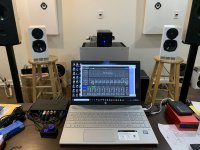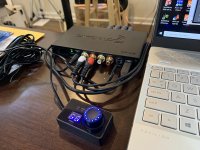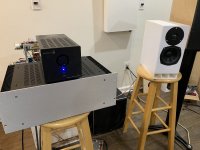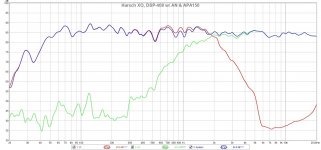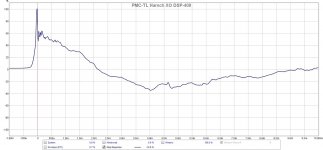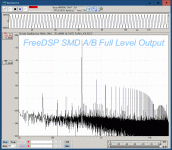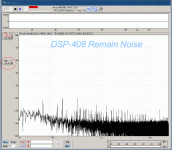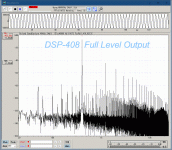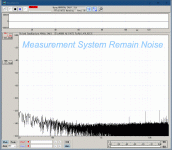There is a new 4x8 analog in analog out DSP from Dayton Audio based on the ADAu-1701. I recently got one and testing it out. It works very well and the software is no-nonsense and does everything I need it to on one page (no menus). It has a remote control (optional) that allows digital volume adjustment and selection of 1 of 6 presets without needing to connect to a computer. It also has an optional Bluetooth dongle that allows streaming or programing from iOS or Android from your phone/tablet. The build quality is very good - sturdy heavy CNC milled case with black anodization. Sound is very good too. Wondering if anyone else has experience using this and their reactions.

PC based software for USB programming (this is the only screen):

iOS/Android app for programming via BT:

Remote volume/preset selector:

Dayton Audio DSP-408 4x8 DSP Digital Signal Processor for Home and Car Audio
Fron manufacturer's website:
Here is my first test of the DSP408, was to use it for my 2-way PMC TL cone (desribed here), with an Alpha Nirvana 40w Class A amp for the 5in woofer and the Dayton APA-150 Class AB for the dome tweeter. Here is the overall setup in my lab:
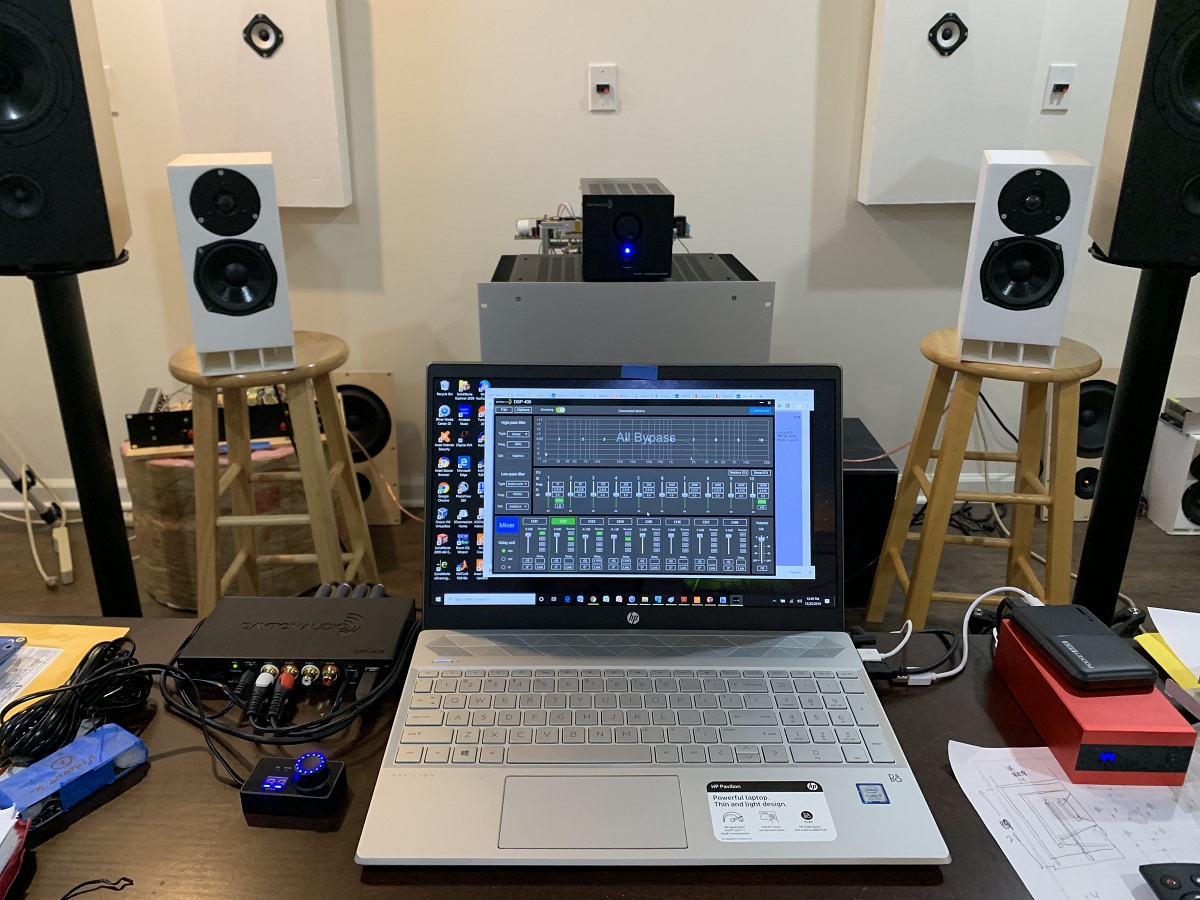
Here is a closeup of the DSP408 and remote:
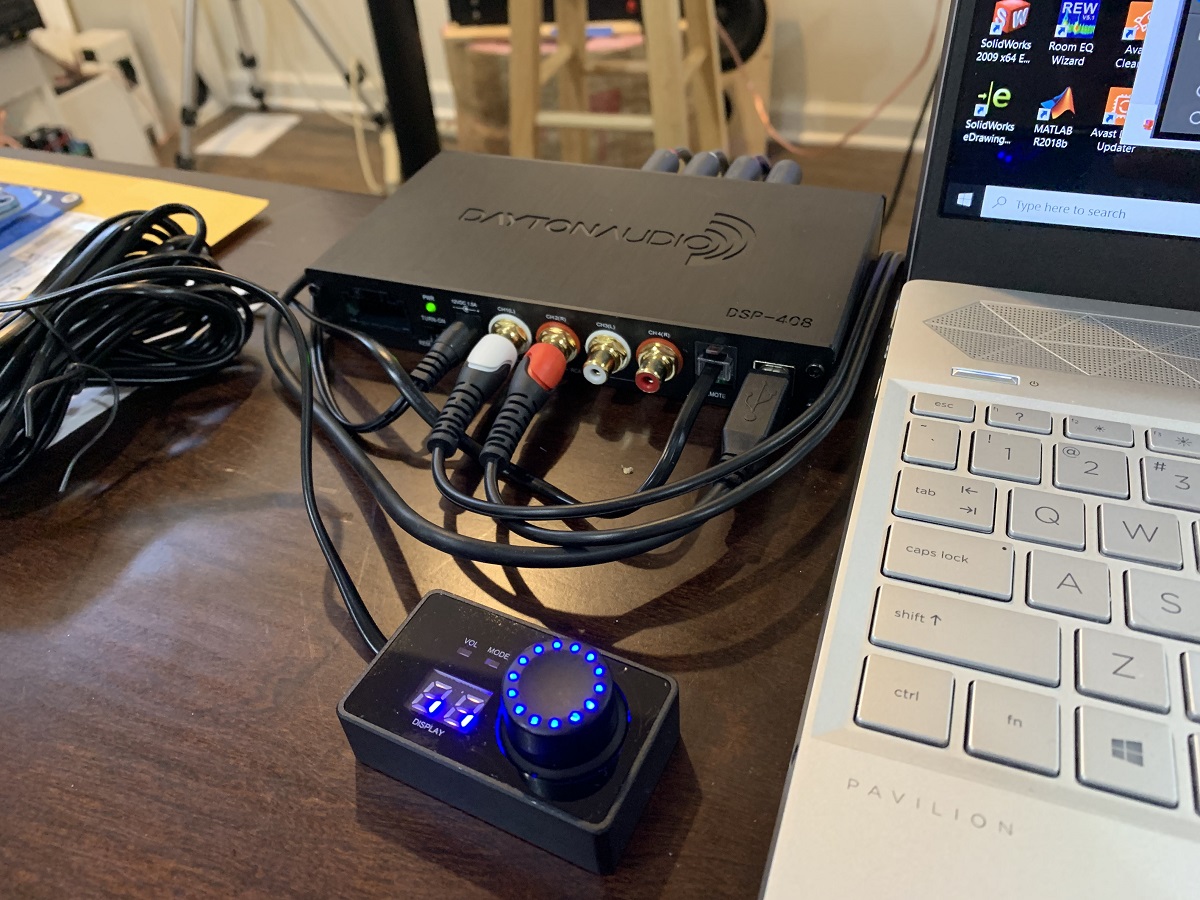
Here is a closeup of the amps and the speaker:

Here is the measured frequency response of the speaker with a Harsch XO (described here) quasi-transient perfect crossover:
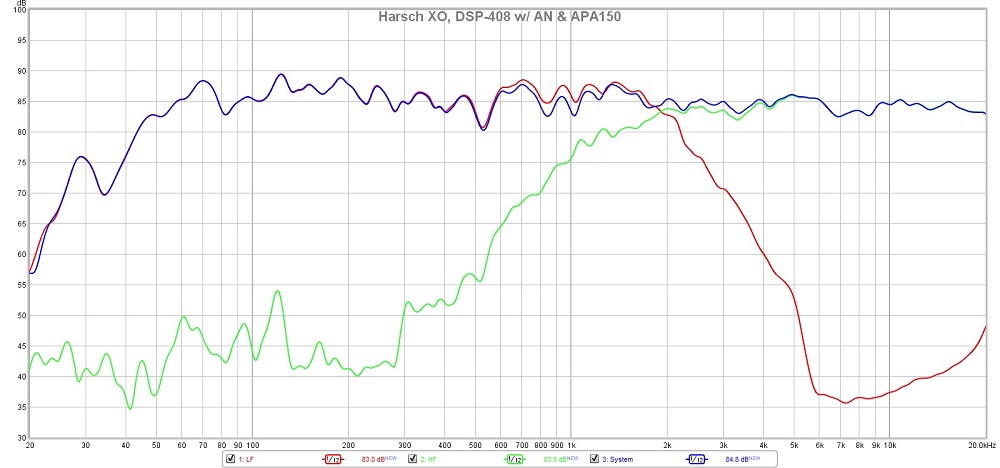
Here is the measured step-response of the Harsch crossover - this is better than I was able to achive with a miniDSP for some reason. The right triangle is distinct and less "loaf of bread" shaped. It may be better amps, I don't know as last time I did this was using a pair of TPA3116's.
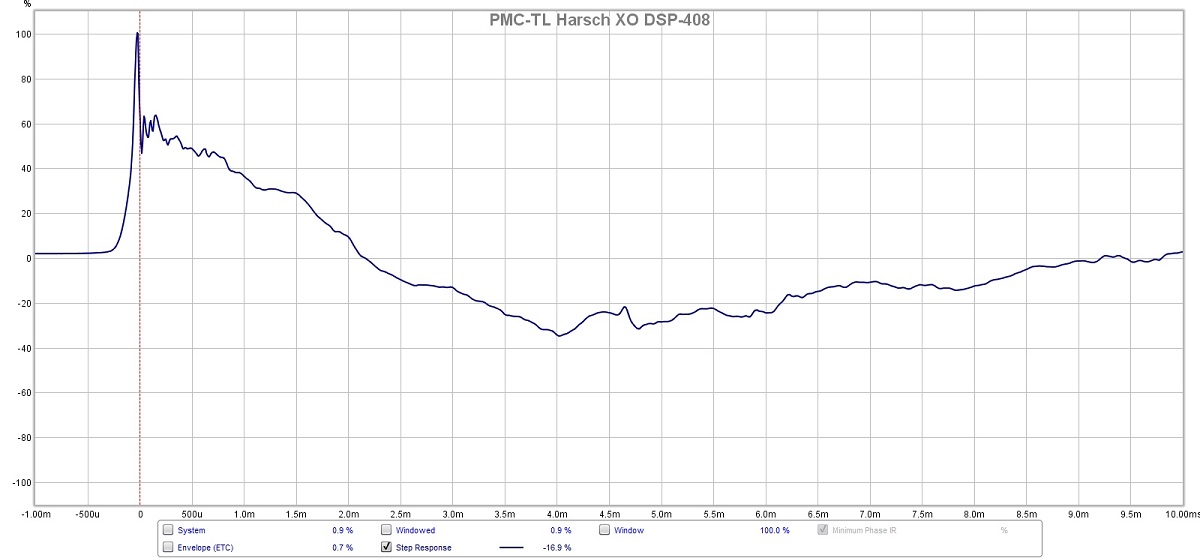
Overall, a very respectable performer and easy to use. I set all this up in 15 minutes from turn-on.

PC based software for USB programming (this is the only screen):

iOS/Android app for programming via BT:

Remote volume/preset selector:

Dayton Audio DSP-408 4x8 DSP Digital Signal Processor for Home and Car Audio
Fron manufacturer's website:
Specifications: • Chipset: Analog Devices ADAU1701 SigmaDSP 28/56-bit Audio Processor • Sampling: 24-bit/48 kHz • RCA inputs: 4 • RCA outputs: 8 • High-level inputs: 4 • High-level input impedance: 180 ohms • Maximum speaker input level: ≤8V • RCA input impedance: ≥20,000 ohms • Frequency response: 20-20,000 Hz • THD+N: 0.008% • Output impedance: <50 ohms • Maximum input level: ≤3.2V • RCA output: 3.5V rms • Signal to noise ratio: ≥115 dB • Remote out current: >500 mA • Power adapter input voltage: 100-240 VAC • Power adapter output: 12 VDC, 1.5A • Operating voltage: 9-17V • Dimensions: 6.53" W x 1.02" H x 4.55" L.
Here is my first test of the DSP408, was to use it for my 2-way PMC TL cone (desribed here), with an Alpha Nirvana 40w Class A amp for the 5in woofer and the Dayton APA-150 Class AB for the dome tweeter. Here is the overall setup in my lab:
Here is a closeup of the DSP408 and remote:
Here is a closeup of the amps and the speaker:
Here is the measured frequency response of the speaker with a Harsch XO (described here) quasi-transient perfect crossover:
Here is the measured step-response of the Harsch crossover - this is better than I was able to achive with a miniDSP for some reason. The right triangle is distinct and less "loaf of bread" shaped. It may be better amps, I don't know as last time I did this was using a pair of TPA3116's.
Overall, a very respectable performer and easy to use. I set all this up in 15 minutes from turn-on.
Attachments
Last edited:
The manual says that the shortest delay to be entered is one cm as only whole numbes can be entered. This would be also the smallest step if I understand it correctly? In US, you can get it for an unbelievable price. Here in Europe, the alternative is to buy two Thomanm DSP 4x4 mini. It has basically identical features, but you would need two to get 8 output - that is how I use mine. There is also no BT and mobile device support, on the other hand, it is fully balanced and the resolution for the delay is better and extremely long delays are possible.
Saying all that, the Dayton DSP is on my watch list, it should be a very handy device.
Saying all that, the Dayton DSP is on my watch list, it should be a very handy device.
The manual says that the shortest delay to be entered is one cm as only whole numbes can be entered. This would be also the smallest step if I understand it correctly? In US, you can get it for an unbelievable price. Here in Europe, the alternative is to buy two Thomanm DSP 4x4 mini. It has basically identical features, but you would need two to get 8 output - that is how I use mine. There is also no BT and mobile device support, on the other hand, it is fully balanced and the resolution for the delay is better and extremely long delays are possible.
Saying all that, the Dayton DSP is on my watch list, it should be a very handy device.
Sound imports is selling the dsp-408 for €179.95
Is marginally more expensive than buying 2 thomman dsp4x4.
Have you seen more expensive than €180?
I also used to use dual 2x4 miniDSP in order to keep costs down for a multiway stereo setup. But programming two separare ones was pain. I agree that shipping costs for PE stuff to other places on earth can sometimes be obscene and indeed we are lucky in the US to have access to so much DIY stuff. OTOH, it is hard for us to get hold of many made-in Europe drivers that are not mainstream from the big companies in DK or Italy.
I am retesting it now with the outputs going to a headphone amp and listening critically. There is hum - maybe 120Hz when the remote volume controller is plugged in. I am contacting PE tech support to see if this issue can be resolved. Was the noise issue you heard about similar? I suspect it might be the very long remote cable, or it might be the digita LED display driver that gives it a very bright display that is generating the noise.
Edit: when I first plug the remote volume controller in, it has a "thinking" rotating LED display symbol like it is a booting up a small microntroller on the remote, then when the remote gets connected and displays a solid number of the volume setting, the hum locks on and becomes very audible. It is not a ground loop but a micro-controller or LED display generated hum from the remote. So, the remote might be used strictly for setting the preset and volume, then disconnected for real use. Kind of a problem.... not a dealbreaker, but not ideal.
Edit: when I first plug the remote volume controller in, it has a "thinking" rotating LED display symbol like it is a booting up a small microntroller on the remote, then when the remote gets connected and displays a solid number of the volume setting, the hum locks on and becomes very audible. It is not a ground loop but a micro-controller or LED display generated hum from the remote. So, the remote might be used strictly for setting the preset and volume, then disconnected for real use. Kind of a problem.... not a dealbreaker, but not ideal.
Last edited:
Not intending to be pessimistic, but I am seriously doubting the 115db s/n claims by the manufacturer.
A bit hesitant to ask you this, but you do have some decent hardware laying about. Perhaps you could get a loopback measurement of some quality, with some of the claims of your other gear, I expect at least 105db s/n should be possible.
Pretty please?
A bit hesitant to ask you this, but you do have some decent hardware laying about. Perhaps you could get a loopback measurement of some quality, with some of the claims of your other gear, I expect at least 105db s/n should be possible.
Pretty please?
Member
Joined 2018
F.Y.I.
Here you can see the inside picture of Dayton Audio DSP-408.
DaytonAudio DSP-408 Teardown
Regards,
CyberPit
Here you can see the inside picture of Dayton Audio DSP-408.
DaytonAudio DSP-408 Teardown
Regards,
CyberPit
Here is a translation of the “Impressions”:
It is a perfect choice if you feel that it has the necessary and sufficient functions and sound quality at a reasonable price, similar to an analog network circuit, "If you decide once you do not need to change it frequently" Will. This DSP stone has a very high degree of integration and excellent cost performance, and software development can be realized without writing a single line of code. I started the idea of doing DIY, I think I can introduce it soon
Not intending to be pessimistic, but I am seriously doubting the 115db s/n claims by the manufacturer.
A bit hesitant to ask you this, but you do have some decent hardware laying about. Perhaps you could get a loopback measurement of some quality, with some of the claims of your other gear, I expect at least 105db s/n should be possible.
Pretty please?
I am asking for a warranty replacement to see if the noise from the volume knob will go away. I’ll test it after I get a replacement.
One thing I have noticed about Dayton products. They don’t embellish or inflate their specs. At least with Dayton drivers - the TS parameters are usually very close. Especially Qts and BL - places where other manufacturers routinely inflate to make it sound like their drivers have bigger magnets than they really do. But data sheet for ADAU1701 says SNR is 104dB. Perhaps their analog section has some noise reduction techniques?
Last edited:
Hi!
I am looking forward to buy a new DSP... do you know hte output voltage of this Dayton unit? Is in single ended or balanced? I would like to drive an ICEpower 500ASP.
Also, is it true the application only goes down to 20hz making iimpossible to use it for subwoofer tuning under that freq.
Finally, this DSP unit have a Speaker Level input... do you know If I can connect my receiver speaker output there? My AVR does not have preamp, so It would be great to do this...
Cheers!
I am looking forward to buy a new DSP... do you know hte output voltage of this Dayton unit? Is in single ended or balanced? I would like to drive an ICEpower 500ASP.
Also, is it true the application only goes down to 20hz making iimpossible to use it for subwoofer tuning under that freq.
Finally, this DSP unit have a Speaker Level input... do you know If I can connect my receiver speaker output there? My AVR does not have preamp, so It would be great to do this...
Cheers!
The specs say 3.2vrms output which is quite high. I had no problem driving my amp to clip. It says 8v (I assume rms) input max for speaker level inputs. I have not tested this feature. Output is single ended RCA not balanced.
If you don’t need all 8 outputs you could synthetically make balanced out via DSP and flip phase on complement output.
If you don’t need all 8 outputs you could synthetically make balanced out via DSP and flip phase on complement output.
Last edited:
I am asking for a warranty replacement to see if the noise from the volume knob will go away. I’ll test it after I get a replacement.
One thing I have noticed about Dayton products. They don’t embellish or inflate their specs. At least with Dayton drivers - the TS parameters are usually very close. Especially Qts and BL - places where other manufacturers routinely inflate to make it sound like their drivers have bigger magnets than they really do. But data sheet for ADAU1701 says SNR is 104dB. Perhaps their analog section has some noise reduction techniques?
For sure, I've nothing against Dayton in any way, for the most part great value for money, they also have some pretty solid stuff for a little bit more.
I just have a sneaking suspicion that either they just have a typo there, or they wrote the S/N measurement for the DAC's in a stand-alone circuit?
Somewhat doubt they have used some special majick to reduce noise, and RCA can be a bit noisy so getting better than 110db s/n can be tricky at the other end of the cable. There's a reason balanced interconnects are the thing to do for low noise gear.
DSP-408 works for me...
Thought I would chime in with my DSP-408 experience. I acquired it to use for mix-and-match experimentation related to my "Silk Purse" project---an attempt to get Cornscala sound quality from vintage high quality PA drivers snagged on the cheap ("sow's ears") from Craigslist. It's a work in process, but so far I am thrilled by the sound quality I am obtaining, easily surpassing my Crites-upgraded Klipsch Forte I's, especially in imaging and midrange transparency. I attribute the imaging performance to the inherent temporal fidelity of digital crossovers, the delays I am applying for signal path and group-delay compensation, and close electromechanical matching of left and right driver pairs from tight manufacturing tolerances. The DSP has performed admirably; my only negatives are occasional low level funky noises on startup and a rather underinformative operating manual, especially in the area of program/preset management. Noise is not a problem to my aging ears except for cable noises from some long interconnects, usually manageable through gain structuring. I could also wish for digital ins to bypass the input ADCs, but I'm "complaining" all the way to my no-AC barn-loft lab where I tolerate harsh environmental extremes to revel in the listening experience into the wee hours. Thanks to Dayton for making this possible on a slim budget!
Thought I would chime in with my DSP-408 experience. I acquired it to use for mix-and-match experimentation related to my "Silk Purse" project---an attempt to get Cornscala sound quality from vintage high quality PA drivers snagged on the cheap ("sow's ears") from Craigslist. It's a work in process, but so far I am thrilled by the sound quality I am obtaining, easily surpassing my Crites-upgraded Klipsch Forte I's, especially in imaging and midrange transparency. I attribute the imaging performance to the inherent temporal fidelity of digital crossovers, the delays I am applying for signal path and group-delay compensation, and close electromechanical matching of left and right driver pairs from tight manufacturing tolerances. The DSP has performed admirably; my only negatives are occasional low level funky noises on startup and a rather underinformative operating manual, especially in the area of program/preset management. Noise is not a problem to my aging ears except for cable noises from some long interconnects, usually manageable through gain structuring. I could also wish for digital ins to bypass the input ADCs, but I'm "complaining" all the way to my no-AC barn-loft lab where I tolerate harsh environmental extremes to revel in the listening experience into the wee hours. Thanks to Dayton for making this possible on a slim budget!
Nice to hear that you are happy with the unit!
Do you also have the volume control module?
What kind of source and power amps are you matching it with?
I do not have the wired remote, but I do have and use the Bluetooth dongle---works great for tweaks from the sweet spot. Source is analog output of a laptop streaming Amazon Music HD via a wifi booster module located halfway between my house router and the barn. Power amp is an older Onkyo 7.1 AVR with 7.1 discrete analog inputs, in direct mode, which gives me remote gain control and plenty of clean power for all 7 channels (2x 3-way mains plus sub).
The sub is not vintage, but an 18" B&C pro cinema driver in a DIY cabinet. The Onkyo is not rated for the 4 ohm sub, but has plenty enough power for it without triggering overload protection.
The other drivers are Altec/JBL-quality TOA woofers and tweeters (from their 380SE mains) and University ID40 alnico midrange comp drivers on Mitchell hand-laid fiberglass radial horns a la JBL 2345. Judicious parametric EQ via the DSP-408 is applied on all drivers. One of these days I'll break away from listening and try the Altec-esque TOA mid drivers (aluminum diaphragms) on the Mitchell horns to see if I like them better than the University drivers (phenolic diaphragms).
My total cost for drivers, DSP, and amp: $600.
the adau1701 max out at 10dB ADC and 104dB DAC
I have a minidsp and i really like the ADAU1701 as a low cost decent unit. Its unity gain at max .9 volts is an issue if you have a signal that is hotter, unless it is attenuated down to .9V, ADC to DSP to DAC (.9V max out) and then buffered to the desired voltage.
In the minidsp there is a jumper to feed 2.1 volts to the unit, all it does is attenuate the signal since the ADAU1701 cannot process higher voltage or produce higher voltage. I imagine that you could bypass the DAC of the unit and add a different DAC but that would not change the fact that the ADAU1701 max out at .9 volt
Looking at the specs of the chip, it makes me seriously doubt Dayton claims. Nevertheless, is a great software and hardware package.
From Analog.com, specs of the DSP chip
ADAU1701 Datasheet and Product Info | Analog Devices
28-/56-bit, 50 MIPS digital audio processor
2 ADCs: SNR of 100 dB, THD + N of −83 dB
4 DACs: SNR of 104 dB, THD + N of −90 dB
Complete standalone operation
Self-boot from serial EEPROM
Auxiliary ADC with 4-input mux for analog control
GPIOs for digital controls and outputs
Fully programmable with SigmaStudio graphical tool
28-bit × 28-bit multiplier with 56-bit accumulator for full double-precision processing
I have a minidsp and i really like the ADAU1701 as a low cost decent unit. Its unity gain at max .9 volts is an issue if you have a signal that is hotter, unless it is attenuated down to .9V, ADC to DSP to DAC (.9V max out) and then buffered to the desired voltage.
In the minidsp there is a jumper to feed 2.1 volts to the unit, all it does is attenuate the signal since the ADAU1701 cannot process higher voltage or produce higher voltage. I imagine that you could bypass the DAC of the unit and add a different DAC but that would not change the fact that the ADAU1701 max out at .9 volt
Looking at the specs of the chip, it makes me seriously doubt Dayton claims. Nevertheless, is a great software and hardware package.
From Analog.com, specs of the DSP chip
ADAU1701 Datasheet and Product Info | Analog Devices
28-/56-bit, 50 MIPS digital audio processor
2 ADCs: SNR of 100 dB, THD + N of −83 dB
4 DACs: SNR of 104 dB, THD + N of −90 dB
Complete standalone operation
Self-boot from serial EEPROM
Auxiliary ADC with 4-input mux for analog control
GPIOs for digital controls and outputs
Fully programmable with SigmaStudio graphical tool
28-bit × 28-bit multiplier with 56-bit accumulator for full double-precision processing
Member
Joined 2018
DSP408 Actual Performance Checked
Hi Frabor-San,
I have DSP-408. So I checked the remain noise spectrum.
I used Roland QuadCapture USB-Audio I/F. Sorry, this device has a lot of distortion (Soft Clipping H/W). As a matter of fact, we can not know the sound fidelity but it's enough to see the remaining noise level.
I also attached FreeDSP SMD A/B Board measurement results, so you can compare the characteristic differences.
The attached figures are as follows...
1. Measurement System remain Noise
2. DSP-408 FULL LEVEL OUTPUT
3. DSP-408 REMAIN NOISE
4. FreeDSP SMD A/B FULL LEVEL OUTPUT
5. FreeDSP SMD A/B REMAIN NOISE
Now I can say the ADI specification is real and Non-Weighted.
DSP-408 remain noise level was almost close to my FreeDSP SMD A/B.
I wonder Dayton's specification (≥115dB) is missing some important condition(s) note such as A-Weighted, CCIR-Weighted or Muting, etc...
Additional information:
FreeDSP SMD A/B is my design. It designed as Unity-Gain and 2Vrms I/O. Inverted phase DAC output filter design.
freeDSP | An Open-Source Low-Budget Audio DSP
DIY DSP PROCESSOR PROJECT PAGE
CyberPit
Looking at the specs of the chip, it makes me seriously doubt Dayton claims. Nevertheless, is a great software and hardware package.
From Analog.com, specs of the DSP chip
ADAU1701 Datasheet and Product Info | Analog Devices
28-/56-bit, 50 MIPS digital audio processor
2 ADCs: SNR of 100 dB, THD + N of −83 dB
4 DACs: SNR of 104 dB, THD + N of −90 dB
Complete standalone operation
Self-boot from serial EEPROM
Auxiliary ADC with 4-input mux for analog control
GPIOs for digital controls and outputs
Fully programmable with SigmaStudio graphical tool
28-bit × 28-bit multiplier with 56-bit accumulator for full double-precision processing
Hi Frabor-San,
I have DSP-408. So I checked the remain noise spectrum.
I used Roland QuadCapture USB-Audio I/F. Sorry, this device has a lot of distortion (Soft Clipping H/W). As a matter of fact, we can not know the sound fidelity but it's enough to see the remaining noise level.
I also attached FreeDSP SMD A/B Board measurement results, so you can compare the characteristic differences.
The attached figures are as follows...
1. Measurement System remain Noise
2. DSP-408 FULL LEVEL OUTPUT
3. DSP-408 REMAIN NOISE
4. FreeDSP SMD A/B FULL LEVEL OUTPUT
5. FreeDSP SMD A/B REMAIN NOISE
Now I can say the ADI specification is real and Non-Weighted.
DSP-408 remain noise level was almost close to my FreeDSP SMD A/B.
I wonder Dayton's specification (≥115dB) is missing some important condition(s) note such as A-Weighted, CCIR-Weighted or Muting, etc...
Additional information:
FreeDSP SMD A/B is my design. It designed as Unity-Gain and 2Vrms I/O. Inverted phase DAC output filter design.
freeDSP | An Open-Source Low-Budget Audio DSP
DIY DSP PROCESSOR PROJECT PAGE
CyberPit
Attachments
Member
Joined 2018
- Home
- Source & Line
- Digital Line Level
- Dayton Audio DSP-408
